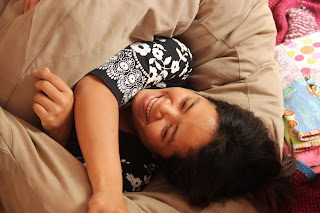For those of you who have asked me what I do specifically at Epic Arts...here it is:
On Mondays the older class arrives by tuk tuk at 8:30. They sing a good morning song and go through a visual schedule for their gardening class. They are divided into groups and pick up rubbish around the centre, water plants, weed and plant seeds. At 10:00 they break for a snack, usually bananas or rambutans and afterwards they wash their gloves, aprons, hats and boots.
At 12:00 Epic has a break until 2pm. Yes you read right, a 2 hour lunch break during the hottest part of the day. When I first came I was amazed but now it's not long enough!
Between 12 and 2 I go to Epic Arts Cafe in town for an Ice Coffee with sweet milk and a chicken salad or omelette.The 2 hours goes really fast and it's so hot, you really can't be very active.
On Mondays at 2pm the younger class arrive and have a hello song and go through a story book. The last book I wrote was about a boy and girl going to the beach and I included activities such as digging in sand for shells, rolling on the beach, getting sprayed by water, eating ice cream, putting on sunscreen and being 'nipped' by crabs. The latest book is about a girl who gets a toothache from eating to many sweet foods and explains how to brush your teeth, quite a pertinent topic for many of our students who already have many rotten teeth from poor diet and oral hygiene. After the story they have free play, either in our wendy house, which is decked out inside with the week's theme, our new playground and sand pit, or water play.
On Tuesdays the older class cook vegetable noodle soup, Wednesdays they have dance and movement with the VTP (Vocational Training Program) students, who are either deaf or have physical disabilities from polio, and Thursdays they do handicrafts. The handicrafts have included making paper beads and lacquering them with nail varnish, making paper mache bowls, making beaded necklaces and currently doing a textile mural with Kate who is a AVID volunteer from Australia.
In between lessons I am busy preparing training workshops. I've done one on sensory processing for the special ed team and one on Autism for the whole Epic staff. I've also run a workshop on activities of daily living and backwards chaining techniques using the example of washing clothes. I'm also preparing a workshop for next Friday on Intensive Interaction.
The last few weeks I've been creating a sensory room and after this weekend it should be completed. It looks great on a $300 budget!
I've also created a wheelchair adaptation and got a floor seat made for Sok.
Sok has a stretching program twice a week, but it's really hard to get it done regularly as we all know exercise is so boring!
So introducing the beautiful little ones...
SOMATH
 |
| Somath with chewy tube. Yay something I'm allowed to mouthe! |

SREY PIN
SREY LINE
LEAK
HOAR

SOCHEATA
SREY NICH
VATTANAK
PEATRA
CHIEN



























































